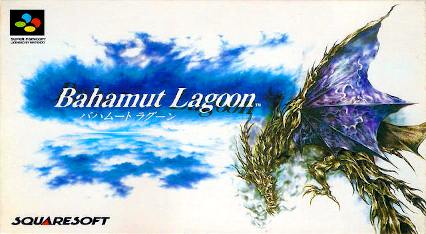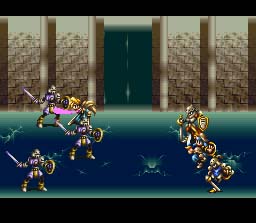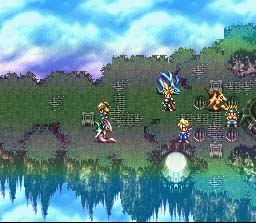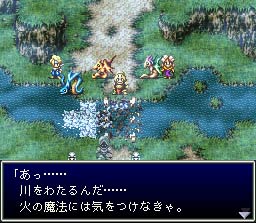Bahamut Lagoon Review
Draconian Methods of Warfare
In early 1996, following two blockbuster hits (Final Fantasy VI and Chrono Trigger), Square released this gem of a strategic role-playing game: Bahamut Lagoon. This game mixes some of the better features found in previous RPGs to create an enjoyable, if slightly flawed experience.
Of primary importance to any strategical game are its battle and formation systems. In Bahamut Lagoon, you control up to six parties of four characters each. Each party is assigned a dragon which assists in combat as well as playing a role in the skill system. Parties can be formed from any combination of your available fighters, with the exception that the main character must always lead the first party. Each type of unit offers a different ability to the party: Heavy Armors can use Smash moves, Light Armors provide extra movement capability, Mages, Priests, and Summoners offer magical prowess, and so on. To add more complexity and thought to the formations, the more units of a given type in a party, the stronger that ability becomes. For example, one Wizard can cast level 10 spells. Put four Wizards in a party and your spells’ power will be increased to the deadly level of 40. Some classes’ specific abilities are governed by the type of dragon they are aligned with – A Wizard’s selection of elemental spells depends on the elemental strength of his party’s dragon.
Battles take place on a party by party basis – First, your parties will move and act one by one, then your enemies will move and act similarly. After your opponents are all finished, you will again have the option of controlling any of your parties. Each party is given a few options to select from each turn. They’re allowed to move a distance based on their ratings and then either attack or use an ability. Items can be used without penalty at any time during a party’s turn, as can healing magic. Attacking proceeds somewhat like a cross between Ogre Battle and Tactics Ogre – Each side in combat gets one attack per party member, but you select your members’ attacks manually. After each combatant has performed an action, combat ends, and experience is assigned, as well as items if you defeat a foe or two. It is the out-of-battle ability usage, though, where Bahamut Lagoon shines. Spells and abilities have the potential to alter the terrain upon which you’re fighting. Having your Wizard party cast a fire spell on a nearby enemy standing in a forest will not only hurt him; the resulting forest fire will set him up for additional suffering if he doesn’t leave quickly. Lightning bolts destroy buildings, ice magic freezes water, earthquakes level mountains… even healing spells can be utilized, purifying swamps and other poisoned areas. These all allow for a great deal of strategy in both attacking and approaching the enemy. Your party’s dragon acts after the party has finished its turn, and can be set to go, come, or wait. Dragons are considerably stronger than your party members, but can be a hindrance, as their A.I. ignores hazards such as auto-cannons and forest fires and has sometimes poor target selection, both of which can result in a dead dragon and the loss of that party’s abilities. Fortunately, all characters and dragons are fully restored at the end of each combat.
The main non-combat activity in Bahamut Lagoon is dragon feeding. Although dragons grow through experience, it’s far more efficient to feed them things from your inventory. Each dragon has HP and MP levels, four primary statistics, five elemental affinities, and a few other miscellaneous stats, all raiseable through gluttony. Feed a dragon a sword and its attack will go up. Not only that, but he’ll grow more aggressive and attack physically more often. Feed it a book and it won’t like you terribly much, but it will grow smarter. Feed it a piece of thunder-elemental armor and it will learn more powerful thunder spells as well as gain more defense. Each stat is rated two ways – by its numeric value and on a scale of 1-10, each mark representing 10% of maximum capacity. Get your dragons to certain combinations on the scale and they’ll evolve, granting new special attacks in battles. The only real downside is that there seems to be no method to feeding a dragon multiple items of the same time at once, leading to tedium if you wish your dragons to be formidable combatants.
The game’s controls are simple but very functional, and menus are fairly comprehensive and generally easy to navigate. However, the game suffers from a lack of amenities. When wandering around, a handy sprint button will help make less time go by. However, battle speed is fairly slow-paced, and could have greatly benefited from an option to turn off animations or to have them go more quickly. The out-of-combat system has its fair share of disadvantages too, from an inability to access the menu except for right before a battle is starting, to the lack of an auto-equip option (48 new pieces of equipment is a lot to equip), and the aforementioned feeding problem.
Bahamut Lagoon also features a fairly nice score. Much of the music isn’t particularly memorable, however it is pleasing to listen to and does well conveying the mood of any given scene. A few of the tracks suffer from overusage, though, especially the main combat theme. The aural aspects of the game are further hurt by low-quality sound effects. Some of them are painful enough to listen to once, let alone several times. For a game released this late in the Super Famicom’s lifespan, this is simply unexcusable, and it’s a shame that it detracts so much from what would otherwise be a fine-sounding game.
On one hand, Bahamut Lagoon is a very derivative game. On the other, it was one of the first to introduce a few concepts which greatly enhance gameplay and the value of good team building. I must say that the ability to affect terrain is one of my favorite features in any strategic game, and adds a wealth of possibilities to most combats. The ability to strengthen and diversify your party through its make-up in several different ways is an added plus, as is the changing of learned magics and techniques depending on what the influence the party’s dragon gives; A lot of the more powerful attacks come at the expense of versatility or even accuracy. These features lift Bahamut Lagoon higher than the strength of its borrowed parts would do.
And although the plot has its share of frequently-used elements, there are quite a few memorable twists in the course of the game, as well as a few surprises in store near the credit roll. For the most part, the game progresses at a steady pace, and plot points are well explained by the dialogue and the characters’ motivations. The characters each possess their own unique personality and grow during the game along with the events that happen, and you may find yourself changing your parties around simply to exclude an unliked member. In stark contrast to the rest, the endgame is long and drawn out, both battlewise and plotwise, and may leave you wondering, like I did, exactly how much longer it will take to get to the end credits. You’ll enjoy getting there, though, as the denouement is satisfying and fairly lengthy of its own accord. We’ve come a long way since the player was just declared to be a winner, that’s for sure.
You may be experiencing this plot several times, too, as Bahamut Lagoon takes a page from Chrono Trigger and offers an option called Ex-Game, which lets you start from the beginning with the statistics and items from your previous playthrough, in addition to an extra spell or two only available in the Ex-Game. Some of the game’s sidequests practically require a high level, and an Ex-Game is a more entertaining way to do it than to simply repeat earlier, easier sidequests. In addition, one of the better dragon forms can only be obtained through the feeding of five rare items, all of which are available in one playthrough, but are very easy to miss. Plus, you’ll also be able to gain satisfaction from mopping the floor with enemies that previously gave you no small amount of trouble, which is always a plus and a reason for another playthrough in my book.
Whether you play through the game once, twice, or more, you should be consistently pleased with the quality of the visuals in the game. Bahamut Lagoon is definitely impressive graphically – While it’s no Star Ocean or Tales of Phantasia, the visuals are crip and colorful, and the animations very fluid and convincing. However, several sprites were noticably taken directly from Final Fantasy VI, which took away something from the game in my eyes. It’s a shame that such a pretty game was marred by a lazy hand or two when it would have taken little effort to create a few more creatures.
This game may prove a shock to those of you raised on the easier side of the tracks; it can be brutally difficult at times. While earlier missions have some leeway, even as early as the fourth level you may find yourself in a sticky situation. The enemies are far more numerous than your characters, and some later enemies have the potential to kill off an entire party with one spell if it’s composed of low hit point characters like Wizards, Priests, or Lancers. Even worse, an attack with a high radius could cripple your whole party concurrently if you plan poorly and clump together. The equalizing force is supposed to be your parties’ dragons, however, their tendency to attack a combative enemy ad nauseum while ignoring the party which heals it every turn, combined with their tendency to be damaged by landscape hazards, can lead to a fair amount of frustration in certain battles.
Bahamut Lagoon is a good, solid strategic RPG, and provides fun and brain-using gameplay. The biggest downside the game has is being in Japanese, with no North American or European release. It’s a shame to think that this wonderful title which I couldn’t put down for a week will never be truly experienced by a non-Japanese speaking audience, as it really is a gem in Square’s collection.


N/A
N/A









Recent Comments